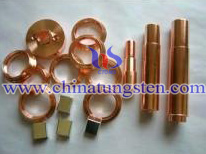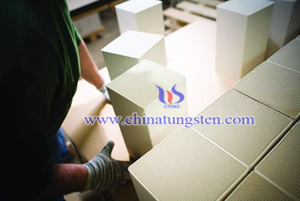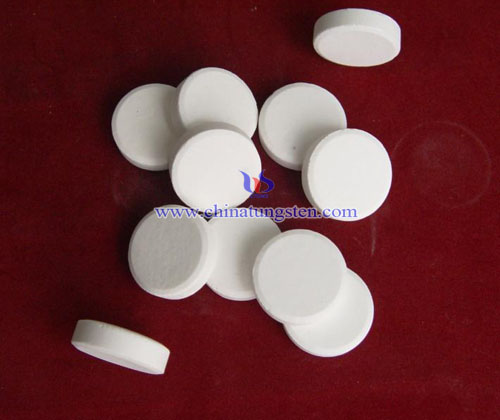Tungsten Copper Contact —Ultrasonic NDT
- Details
- Category: Tungsten Information
- Published on Monday, 30 May 2016 18:37
- Written by xiaobin
- Hits: 270
Tungsten copper contact is also known as tungsten copper electrical contact or tungsten copper contact tip, which is a kind of psudoalloy that consist of W and Cu two kinds metals of immiscible and without the formation of intermetallic compounds. Consequently, it not only has high hardness, high melting point, high strength, low coefficient of thermal expansion and excellent wear resistance and corrosion resistance of W, but also has perfect electrical and thermal conductivity and plasticity of Cu. And it has been played an important role in some high-voltage switch, breaker, and instrument components.
Currently, preparation of tungsten copper contacts is mainly used in PM (powder metallurgy) technology, the corresponding method used for the performance testing, such as the density, the hardness, the compressive strength, the tensile strength and micro-structure, etc., will have some damages on the integrity of tungsten copper products and lead to failure. And these tools to test for products in large quantities can only do a certain proportion of sample, which is difficult to have some representation. If the unqualified tungsten copper contacts undetected used in actual production is likely buried security risk, both for production or personal safety is extremely unfavorable. So the relevant researchers use Non-destructive testing techniques to measure and evaluate the mechanical properties of tungsten copper related products.
Ultrasonic NDT (Non-destructive Testing) is a kind of process that ultrasound can penetrate deep into the use of a metallic material, by entering a cross-sectional another cross-sectional; edge reflection occurs at the interface characteristics of the parts to check for defects. When the ultrasonic beam from the surface of the part by the probe pass to the metal inside encounter defects and Part underside of the reflected wave occurs, respectively, form a pulse waveform on the screen, based on these pulse waveforms to determine the location and size of the defect. Compared with other detecting methods, Ultrasonic NDT has many advantages, such as:
1. Ultrasound has perfect penetration ability, low transmission loss and the probing depth of up to several meters;
2. High sensitivity, it can be found with the diameter of the air-based reflectance 0.1-1mm equivalent reflector;
3. Accurate positioning, to assume the shape and the size are also more accurate;
4. Convenient in operation and it is suitable for the most materials;
5. The entire testing process will not cause environmental pollution, no harm to the human body completely.

| Tungsten Copper Supplier: Chinatungsten Online tungsten-copper.com | Tel.: 86 592 5129696; Fax: 86 592 5129797;Email:sales@chinatungsten.com |
| Tungsten News & Prices, 3G Version: http://3g.chinatungsten.com | Molybdenum News & Molybdenum Price: http://news.molybdenum.com.cn |
Automobile Exhaust Denitration Catalyst Uses Tungsten Trioxide
- Details
- Category: Tungsten Information
- Published on Monday, 30 May 2016 18:36
- Written by chunyan
- Hits: 247
 One of the most challenging tasks in the environmental protection field is to reduce nitrogen oxide in the exhaust emissions. With the daily increasing of the usage amount of global automobile, the automobile exhaust has become one of the main sources of nitrogen oxides, which the governance has become particularly important. There are usually two methods to improve the denitration process of automobile exhaust, which are the methods of improving combustion process and flue gas denitrification. In the methods of improving combustion process, with the process changing, the NOx eliminate efficiency also will show a difference; however, it is denitration efficiency almost controlled among 50~60%. In the flue gas denitrification process, especially the using of catalytic method, its denitration efficiency can reach a relatively high level, and thus to have a widely application.
One of the most challenging tasks in the environmental protection field is to reduce nitrogen oxide in the exhaust emissions. With the daily increasing of the usage amount of global automobile, the automobile exhaust has become one of the main sources of nitrogen oxides, which the governance has become particularly important. There are usually two methods to improve the denitration process of automobile exhaust, which are the methods of improving combustion process and flue gas denitrification. In the methods of improving combustion process, with the process changing, the NOx eliminate efficiency also will show a difference; however, it is denitration efficiency almost controlled among 50~60%. In the flue gas denitrification process, especially the using of catalytic method, its denitration efficiency can reach a relatively high level, and thus to have a widely application.| Tungsten Oxide Supplier: Chinatungsten Online www.tungsten-oxide.com | Tel.: 86 592 5129696; Fax: 86 592 5129797;Email:sales@chinatungsten.com |
| Tungsten News & Prices, 3G Version: http://3g.chinatungsten.com | Molybdenum News & Molybdenum Price: http://news.molybdenum.com.cn |
Tungsten Powder made by Waste Tungsten Bar- Chemical Vapor Migration
- Details
- Category: Tungsten Information
- Published on Monday, 30 May 2016 10:13
- Written by xuejiao
- Hits: 239
With the rapid development of industry, although it has high economic benefits, but the damage of the environment is on the increase every year. Due to ecological environment worsening and water resource shortage, the human living environment will face the serious challenge. The ecological environment is fragile, and the task of ecological construction and environmental protection is still heavy. And therefore countries pay more and more attention to the recovery of metals. Japan set up a special committee for tungsten recovery in 1975, which is called WR for short. The commission estimates that 31.3 tons of tungsten can be recycled while producing 100 tons of carbide. Or we can say that is the 31.3 percent recovery, the actual recovery rate in Japan is 10% and the United States is 20%. The equipment for chlorination pulping process is relatively simple, and it has a wide adaptability of raw materials, at present, this method is considered as one of the most promising methods. In recent years, ultrafine tungsten powder extracted from the waste tungsten bar through the chemical vapor migration has aroused general concern. Chemical vapor migration is a chemical process used to produce high quality, high-performance, solid materials. The process is often used in the semiconductor industry to produce thin films. Microfabrication processes widely use this way to deposit materials in various forms, including monocrystalline, polycrystalline, amorphous, and epitaxial.
The first is to use chloridize the cutting of both ends of the clamping head of tungsten bar while vertical sintering at environment of 950 ℃. Chloride will be supplied to reduction tubes with argon, and then being deoxidized by hydrogen. Chlorine is loaded in industrial bottle, and mixed with argon after dehydrating by concentrated sulfuric acid. Deoxidizing hydrogen with palladium asbestos at the temperature of 350 ℃, then drying it by silica gel and molecular sieve. Finally, gathering the ultrafine tungsten powder obtained by the reaction in powder collecting pipe. After purifying and absorbing hydrogen chloride, exhaust gas which contains hydrogen would be emitted and combustion. The final wolfram powder would have 0.64% oxygen, 0.075% chlorine, and 0.033% chlorinated residue.
Adopting chemical vapor migration methods can also produce the same quality of wolfram powder. Although the aluminum content is higher, all other metal impurities are mostly below or equal to the ultrafine wolfram powder. On the one hand, it can greatly reduce industrial costs. On the other hand, it helps to promote the application of wolfram powder.

| Tungsten Metals Supplier: Chinatungsten Online www.tungsten.com.cn | Tel.: 86 592 5129696; Fax: 86 592 5129797;Email:sales@chinatungsten.com |
| Tungsten News & Prices, 3G Version: http://3g.chinatungsten.com | Molybdenum News & Molybdenum Price: http://news.molybdenum.com.cn |
Tungsten Bronze Metaniobate Lead High Temperature Ceramics Preparation
- Details
- Category: Tungsten Information
- Published on Monday, 30 May 2016 15:48
- Written by xinyi
- Hits: 276

| Tungsten Oxide Supplier: Chinatungsten Online www.tungsten-oxide.com | Tel.: 86 592 5129696; Fax: 86 592 5129797;Email:sales@chinatungsten.com |
| Tungsten News & Prices, 3G Version: http://3g.chinatungsten.com | Molybdenum News & Molybdenum Price: http://news.molybdenum.com.cn |
Tungsten Bar and Satellite
- Details
- Category: Tungsten Information
- Published on Monday, 30 May 2016 10:10
- Written by xuejiao
- Hits: 301
In the context of spaceflight, a satellite is an artificial object which has been intentionally placed into orbit. Such objects are sometimes called artificial satellites to distinguish them from natural secondary planets such as moon. The world's first artificial secondary planet, the Sputnik 1, was launched by the Soviet Union in 1957. In the whole solar system, except for Mercury and Venus, the other planets are all natural objects. Wolfram is a rare non-ferrous metal in the world, and its annual output is very low. In addition, it is very versatile and mainly applied in the casting material. Nowadays, the total number of natural objects is at least 160. For example, in the solar system, the sun is a fixed star, and the earth and other planets orbit around the sun, and the moon and other planets orbit around the earth, these planets are called natural secondary planet.
Not long ago, there has been a weapon called satellite powered gun, which is also known as "God's scepter." This is an extraterrestrial combat device which is still being researching and developing. Theoretically, this weapon can shoot to the ground with tungsten bar through its track, and it can cover any range of the entire planet. Tungsten metal is lustrous and silvery white in color, and does not occur naturally (it has an abundance of 1 ppm in the earth's crust). Attack that originates from space, not only has the capability to destroy large tracts of ground buildings, but also destroys hundreds of meters deep underground bunkers. Powered gun can hit the ground by gravity, and it can be accelerated to the speed of 3403 m / sec which is the same as the destruction of nuclear weapons, but it would not cause catastrophic nuclear radiation.
In the movie "GI Joe 2", it is mentioned that the "silos" can be considered as a geostationary secondary planet, tungsten bar will do elliptical motion around the earth with "silos" in the absence of thrust. However, according to the law of conservation of energy, kinetic energy of landing of this type of tungsten products does not exceed its own potential energy of the near-Earth orbit, and its potential energy in the near-Earth orbit cannot exceed kinetic energy of its rocket launching. So, in fact floor kinetic energy of tungsten bar is probably less than a quarter of the rocket fuel energy, and therefore, such weapons are currently still in the theoretical condition.

| Tungsten Metals Supplier: Chinatungsten Online www.tungsten.com.cn | Tel.: 86 592 5129696; Fax: 86 592 5129797;Email:sales@chinatungsten.com |
| Tungsten News & Prices, 3G Version: http://3g.chinatungsten.com | Molybdenum News & Molybdenum Price: http://news.molybdenum.com.cn |





 sales@chinatungsten.com
sales@chinatungsten.com